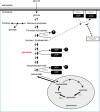Fungal persister cells: The basis for recalcitrant infections?
- PMID: 30335865
- PMCID: PMC6193731
- DOI: 10.1371/journal.ppat.1007301
Fungal persister cells: The basis for recalcitrant infections?
Abstract
Persister cells are a small subpopulation within fungal biofilms that are highly resistant to high concentrations of antifungals and therefore most likely contribute to the resistance and recalcitrance of biofilm infections. Moreover, this subpopulation is defined as a nongrowing, phenotypic variant of wild-type cells that can survive high doses of antifungals. There are high degrees of heterogeneity and plasticity associated with biofilm formation, resulting in a strong variation in the amount of persister cells. The fraction of these cells in fungal biofilms also appear to be dependent on the type of substrate. The cells can be observed immediately after their adhesion to that substrate, which makes up the initial step of biofilm formation. Thus far, persister cells have primarily been studied in Candida spp. These fungi are the fourth most common cause of nosocomial systemic infections in the United States, with C. albicans being the most prevalent species. Remarkably, persisters exhibit characteristics of a dormant state similar to what is observed in cells deprived of glucose. This dormant state, together with attachment to a substrate, appears to provide the cells with characteristics that help them overcome the challenges with fungicidal drugs such as amphotericin B (AmB). AmB is known to induce apoptosis, and persister cells are able to cope with the increase in reactive oxygen species (ROS) by activating stress response pathways and the accumulation of high amounts of glycogen and trehalose-two known stress-protecting molecules. In this review, we discuss the molecular pathways that are involved in persister cell formation in fungal species and highlight that the eradication of persister cells could lead to a strong reduction of treatment failure in a clinical setting.
Conflict of interest statement
The authors have declared that no competing interests exist.
Figures



Similar articles
-
Candida albicans biofilms produce antifungal-tolerant persister cells.Antimicrob Agents Chemother. 2006 Nov;50(11):3839-46. doi: 10.1128/AAC.00684-06. Epub 2006 Aug 21. Antimicrob Agents Chemother. 2006. PMID: 16923951 Free PMC article.
-
Inhibition of nucleic acid biosynthesis makes little difference to formation of amphotericin B-tolerant persisters in Candida albicans biofilm.Antimicrob Agents Chemother. 2015 Mar;59(3):1627-33. doi: 10.1128/AAC.03765-14. Epub 2014 Dec 29. Antimicrob Agents Chemother. 2015. PMID: 25547355 Free PMC article.
-
Protocol for Determination of the Persister Subpopulation in Candida Albicans Biofilms.Methods Mol Biol. 2016;1333:67-72. doi: 10.1007/978-1-4939-2854-5_6. Methods Mol Biol. 2016. PMID: 26468100
-
Mechanisms of Candida biofilm drug resistance.Future Microbiol. 2013 Oct;8(10):1325-37. doi: 10.2217/fmb.13.101. Future Microbiol. 2013. PMID: 24059922 Free PMC article. Review.
-
Antifungal activity against Candida biofilms.Int J Artif Organs. 2012 Oct;35(10):780-91. doi: 10.5301/ijao.5000170. Int J Artif Organs. 2012. PMID: 23138707 Review.
Cited by
-
Novel Bi-Factorial Strategy against Candida albicans Viability Using Carnosic Acid and Propolis: Synergistic Antifungal Action.Microorganisms. 2020 May 16;8(5):749. doi: 10.3390/microorganisms8050749. Microorganisms. 2020. PMID: 32429493 Free PMC article.
-
Facing Foodborne Pathogen Biofilms with Green Antimicrobial Agents: One Health Approach.Molecules. 2025 Apr 9;30(8):1682. doi: 10.3390/molecules30081682. Molecules. 2025. PMID: 40333625 Free PMC article. Review.
-
Trichosporon asahii and Trichosporon inkin Biofilms Produce Antifungal-Tolerant Persister Cells.Front Cell Infect Microbiol. 2021 Apr 22;11:645812. doi: 10.3389/fcimb.2021.645812. eCollection 2021. Front Cell Infect Microbiol. 2021. PMID: 33968802 Free PMC article.
-
Aprepitant, an antiemetic agent, interferes with metal ion homeostasis of Candida auris and displays potent synergistic interactions with azole drugs.Virulence. 2020 Dec;11(1):1466-1481. doi: 10.1080/21505594.2020.1838741. Virulence. 2020. PMID: 33100149 Free PMC article.
-
Inhibition of Candida glabrata Biofilm by Combined Effect of Dendritic Compounds and Amphotericin.Pharmaceutics. 2022 Jul 31;14(8):1604. doi: 10.3390/pharmaceutics14081604. Pharmaceutics. 2022. PMID: 36015230 Free PMC article.
References
-
- Andes DR, Safdar N, Baddley JW, Playford G, Reboli AC, Rex JH, et al. Impact of treatment strategy on outcomes in patients with candidemia and other forms of invasive candidiasis: A patient-level quantitative review of randomized trials. Clin Infect Dis. 2012;54: 1110–1122. 10.1093/cid/cis021 - DOI - PubMed
Publication types
MeSH terms
Substances
LinkOut - more resources
Full Text Sources
Medical
Miscellaneous

